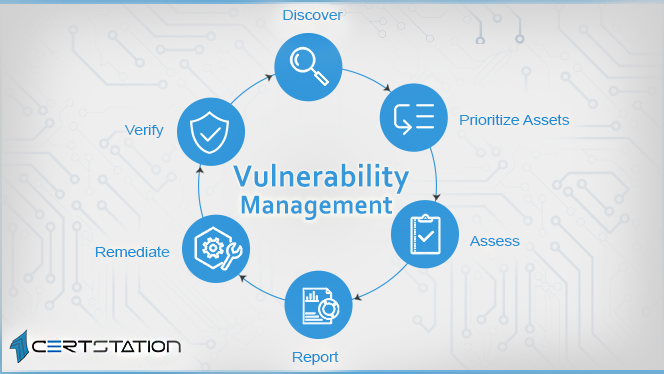
What is Vulnerability Management?
Vulnerability management (VM) is a continuing process that incorporates hands-on asset discovery, unceasing screening, mitigation, remediation and protection strategies to guard your organization’s contemporary IT attack surface from cyber exposure. Regardless of whether you are a cybersecurity executive, an evolving vulnerability management practitioner, or whether you’re thinking of buying a VM platform to reduce your cyber exposure, you ought to have the fundamental know-how of vulnerability management in order to learn how companies and individuals safeguard their systems from cybercriminals and their nefarious activities for ulterior motives.
The Stages of Vulnerability Management
Stage 1: Discover
This primary stage deals with preparing for the vulnerability scans and tests and ensuring your bases are protected, meaning arranging all your company assets and divulging any devices that have been forgotten. In this regard, it’s better to compile all of the assets required to test, ascertain their significance, while working to maintain an incessantly updated catalogue so you can provide a chart of the flaws throughout your network.
Stage 2: Evaluate
After compiling all of your devices and catalogue, the next stage—Evaluation or Assessment—includes the tests to ensure every device is precisely and effectively scanned. The object is not just to know the vulnerabilities, but to acquire timely, resourceful access to the information; you might be squandering time on false hopes if the data you are receiving is not credible. With a slew of vulnerabilities revealed every day, managing them all appeared impossible, which makes it all the more important to prioritize the major risks and resolve those first.
Stage 3: Report
In Stage 3, all this data is then gathered into a custom report, providing details on the vulnerabilities and how to prioritize them. These reports contain recommendations as well as the best plan to reduce the risks rapidly and flawlessly. The stage also includes the actions to take and give step-by-step directives to correct the problem. The objective of the report is to considerably cut the security risk that these susceptibilities present in a practical way.
Stage 4: Remediate
In this fourth stage, the objective is to screen flaws and allocate tickets. As vulnerabilities are spotted and reported, the next step in the vulnerability management process is to fix, assess, or eliminate those vulnerabilities. This can be achieved through the essential updates and fixes or workarounds to circumvent the threat. This stage is then repeated as new flaws are exposed. The network and its devices should be uninterruptedly screened to diagnose and find new vulnerabilities that might lead to potential, future threats.
Stage 5: Verify
The last step is to authenticate the success of the whole process. The objective of this step—which maintains transparency and answerability across the company—is to decrease the attack surface of a company, discover ways to reduce the threat of an attack by reducing vulnerabilities. With an ever-increasing number of vulnerabilities, you ought to prepare your team to counter the threat by investing in a vulnerability management device, thus reducing the risk manifold.
Is vulnerability management different than vulnerability assessment?
Yes, it is. Unlike vulnerability management, a vulnerability assessment is a methodical appraisal of security flaws in an information system. Vulnerability assessment is essentially a key procedure that includes a variety of different sub-procedures. It basically has to do with the recognition, quantification, and status of the different susceptibilities that might exist within a system. Consequently, VA is not only limited to be employed in network-based organizations, but it can be useful for an energy supply system, transportation and communication systems, as well as others.
Preventing unauthorized access to strangers
Vulnerability assessment is a very significant stage for any business that seeks to prevent unlawful access to its systems to strangers. The first step in VA is to list all of the different resources as well as the competences of the system. Then, a calculable value, such as a rank is given to each dissimilar asset or resource in an effort to gauge their significance to the company. Afterwards, a detailed vulnerability scan is conducted on the diverse resources that have been classified in order to ascertain where most of the susceptibilities lie. Doing this allows the organization to determine whether its vital resources are susceptible or not. In addition, a vulnerability assessment also faces and manages corrective situations, as it helps assuage or control different kinds of grave vulnerabilities that might exist within a system connected to its most appreciated resources.
Determining security flaws
A vulnerability assessment also ascertains security flaws within software and/or hardware fundamentals being evaluated. Typically, vulnerability assessments are carried out in an automated way. Different kinds of assessments exist, including network, web application, and software code assessments. All of these various assessments are carried out within days or even weeks, but, essentially, a given assessment is an engagement that is a one-time activity. A company that receives the information collected from a susceptibility assessment will possibly want to take action based on the results. Although conducting a one-time assessment after these actions have been taken are key activities and ingredients of vulnerability management, if a firm halt at a one-time evaluation and does not conduct periodic vulnerability evaluations, no vulnerability management actually takes place. Simply put, so long as the assessments are not repeated over and over again, a vulnerability management cannot be considered to have occurred.
Conclusion
With the constant addition of new mobile devices, cloud services, networks and applications from organizations to their settings, cybercriminals are constantly finding ways to device new threats and strategies. Every new addition or technology raises the risk that your network is prone to being attacked by unscrupulous hackers and cybercriminals.
Whenever an organization gets a new associate partner, employee, client or customer, it opens itself to new opportunities, but it also ends up exposing itself to new threats and risks. A vulnerability management solution can shield your organization from these threats, which can keep up with and adapt to all of these changes. And if that’s taken for granted, attackers will always outfox you.




